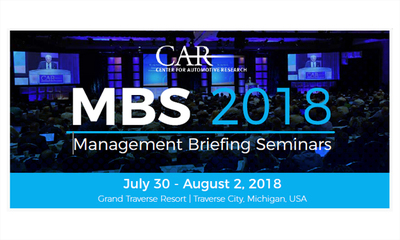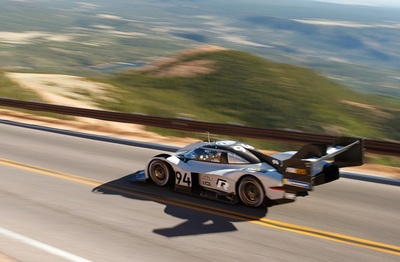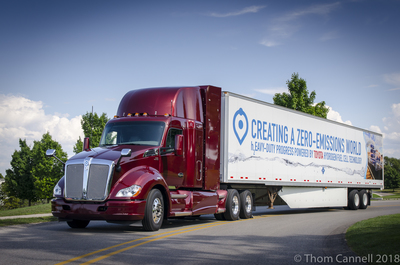Day Two Center for Automotive Research Management Briefing Seminar 2018
 |
By Thom Cannell
Senior Editor and Technology Lead
Michigan Bureau
The Auto Channel
Traverse City MI July 31, 2018; Like any good conference, any premiere conference for thought and business leaders in the automotive space, the Center for Automotive Research offers several options at the annual Management Briefing Seminar. I chose to pursue news on the latest in powertrains, expecting news on a variety of gasoline, hydrogen, diesel and electrified options. While mostly oriented to electrification, there was news on many fronts under the banner, “Are we at the point where everything changes to mobility”. Short answer, no.
First up, Mike Anderson, who runs GM’s transmission, electrification and hardware engineering, was the first to show a forecast of how the industry will change, adding more electrified (not electric) vehicles to the mix of standard IC or internal combustion–powered vehicles. “Uncertainty increases, the longer the forecast,” he said. “Predictors won’t be accountable” for their lack of accuracy. No doubt!
Anderson divides the challenge of futurity into three “lanes,” the first is mild electrification, the second greater hybridization, the third lane battery-electric and fuel cell-powered vehicles. We now see a few mildly electrified vehicles, many using a 48-Volt electric motor and battery to boost fuel economy and power, while lowering emissions. Not the same as a hybrid, though you could include it in that category as both have very limited all-electric range.
What interested me most was the suite of new technology for fuel economy that GM is rolling out. It’s Dynamic Fuel Management and gives us three unique modes of operation, rather than the older Active Fuel Management’s on/off modes for cylinder deactivation (which improves fuel economy). DFM has 17 modes of operation and can totally deactivate two of four cylinders. Their new Tri-Power (not to be confused with old Pontiac carburetors!) will first be available on a new 2.7-liter I-4 engine.
In other lanes, Mike spoke about how GM has built its 20-millionth battery cell, and their pure-electric Bolt and PHEV Volt have crossed the 2.6 billion miles of customer experience. GM is also partnering with a wide variety of suppliers and other automakers, notably a partnership with Honda to mass-produce fuel cells.
Criag Balis, chief technology officer of Honeywell Transport Systems, soon to be known under the familiar Garrett name, talked about their focus on development of turbochargers, as the market continues to develop.
He also showed predictions, that electrified vehicles—mild 48-Volt, PHEV, Battery Electric Vehicles and Fuel Cell Vehicles—may account for 30-percent of sales by 2025. By 2021 he expects 70-percent of mild hybrids to be turbocharged “lower emissions, more torque, more horsepower, and smaller size,” he said.
One thing to look for is more use of electric turbochargers. While consuming 4-6kW in power, because the shaft can connect to a generator, the e-turbo is energy neutral. It will provide improved acceleration, increased fuel economy, lower emissions when used added to a (downsized) conventional engine. Also, Honeywell (Garrett) supplies a novel compressor for fuel cells. Running with no oil (it would poison the fuel cell stack), it runs at 100,000 rpms silently on air bearings.
Ron Frawley director of strategic planning in Magna’s powertrain division, was asked when we see the truly disruptive change in mobility? His responses started with a chart that showed 95-percent IC engines in 2025, but with 2/3 having some form of electrification. And, maybe 9-17-percent BEVs by 2030. He did ask the question, what if customers won’t pay to fulfill legislative requirements. This has vast implications, particularly in California. He also foresees relaxation in some regulations, it’s begun in Europe, and the current administration is pointing there. On the other hand, areas in China and Norway propose banning anything but BEVs relatively soon.
Ron’s presentation focused on a block concept, clearly showing how any automaker could add electrification to existing platforms. For instance, adding a 48-volt electric motor to the rear wheels could increase horsepower 25-percent and lower emissions by 15-percent. So, expect to see that concept embraced.
More complex, and more costly, would be adding a high-Voltage motor to the rear wheels, thereby increasing power by 85-percent and lowering CO2 by 75-percent (on some test cycles). In any of these cases, software could provide both Eco and Sport modes, defaulting to whatever is best for the conditions.
Delphi Technologies chief engineer of advanced R&D John Kirwin disclosed their new 350-bar (5,000+PSI) injection systems result in lower emissions. These are applicable to modern Direct Injected engines, most equipped with turbochargers. They’ve even increased diesel engine injection pressures to 3,000-bar, not as large an increase, but significant. Unless I understood, they’re the supplier of GM’s new cylinder deactivation system.
Delphi is also working hard on 48-Volt and high-voltage power electronics and controllers. A current project is to equip a vehicle with 48-volt mild hybrid technology, add dynamic skip-fire technology, and capture deceleration energy for the hybrid battery. They are halfway into a three-year evaluation, which already had better low-end torque, 20-percent better acceleration, a smoother stop-start system, and 15-percent improved CO2. “Software is an even more important component going forward,” he said.
The following panel talked about being unafraid to terminate lackluster projects, something the industry has been historically slow to embrace. The best quote; “Cost is the main barrier to delivering what our customers want!” Truer words have seldom been spoken.
Following lunch, the future powertrain discussion continued, now about Electrification Strategy, Batteries, Motors and Cars, with representatives from Toyota, Nissan, Volkswagen and supplier Eaton.
Toyota is convinced that some, or much of the future relies on hydrogen as a fuel, particularly for hydrogen fuel cell vehicles. As we noted in our first report, they’ve built a second, or Beta version of their over-the-road semi, to be used at the port of Long Beach and the Port of Los Angeles. The truck has an 80,000-pound capacity, including its own weight, and makes 670 horsepower and 1,375 pound-feet of torque from its two Mirai fuel cells. Andrew Lund, chief engineer on the project, noted that freight on America’s highways will grow significantly by 2029, with accompanying emissions. Zero emissions vehicles like Beta, provide a solution though it 300-mile range is, for now, limiting, as is cost. It’s a work in progress.
Toyota is also focused on BEVs, particularly for China, and has a goal selling 5.5-million electrified (not BEVs) vehicles per year by 2030.
The chief engineer on Nissan’s new Leaf Chris Reed, talked about their 330,000 sales, and Nissan’s vision of zero emissions, zero fatalities. Note that Nissan has 192 cells per vehicle, 60-million cells in on-the-road vehicles, and zero serious incidents to date…
He also mentioned Nissan’s $60-million dollar investment in BEV charging infrastructure, and how that enormous cost is the proverbial drop in the bucket when compared to what’s necessary for a robust e-future.
By 2020, the Renault-Nissan-Mitsubishi alliance plans 12 new pure EVs by 2020, and we should expect an updated Leaf with improved range, later this year.
Eaton Company, well known as a heavy-duty supplier, surprised many of us with its parallel knowledge in industrial power systems and electronics. They well understand high-voltage systems and showed the effect of a short circuit of 400-Volts. Think grenade explosion!
They pointed to the rapidly increasing battery pack voltage as a source of concern; Porsche’s announced Taycan pack will approach 800 Volts. That’s good for Porsche, more power, faster charge times, potentially not so good for first responders.
His last admonition was that fuses, and all hybrids, PHEVs, BEVs have them, wear out. Who knew?
Volkswagen’s Matthew Renna had the sexiest leadoff slide, the Pike’s Peak-winning VW I.D. R. You should look at the video!
VW is building a Modular Electrification Toolkit similar to the kit they use for conventional vehicles. Think pancake with wheels. The platform, essentially a battery pack with electronics, makes it possible to add-in larger wheels, build rear wheel or all wheel drive vehicles, select the passenger space, and more. It’s smart.
The first VW e-vehicles will have a 200-mile range with 30-minute charge to 80-percent capacity. They’ll increase the range as technology allows. The announced I.D. Crozz will appear in 2020, followed by a sedan, a CUV, and then the I.D. Buzz “minivan”.
In the Q&A, Toyota explained that their Alpha and Beta trucks are fueled with hydrogen produced from a plant powered by agricultural waste, so near-zero environmental impact.
Participants agreed that the next step, Real Soon, would be solid-state batteries. Many are working on them. And in-road charging—they’re trying it in Sweden—could change the game. And the Omni-present question of range produced “What is normal, a non-stop blast to California, Colorado, or Florida, or everyday commuting”? That’s a continuing discussion.




